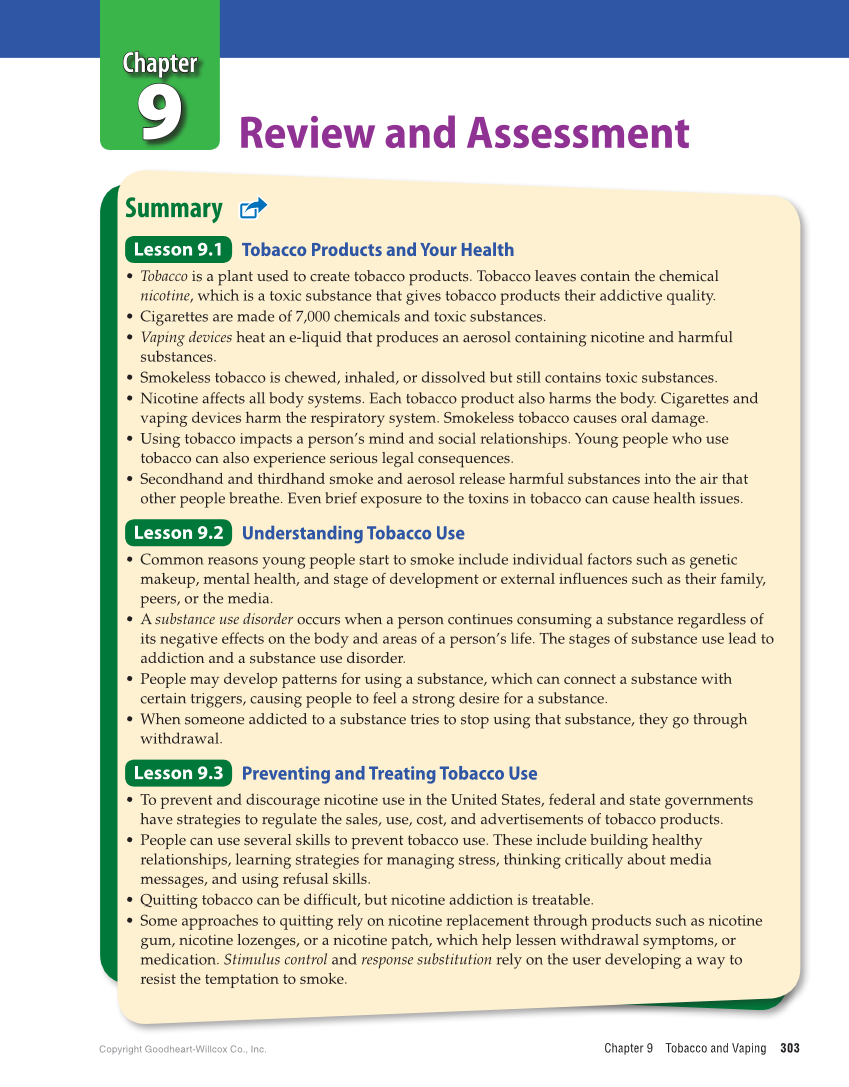303 Copyright Goodheart-Willcox Co., Inc. Chapter 9 Tobacco and Vaping Summary Lesson 9.1 Tobacco Products and Your Health • Tobacco is a plant used to create tobacco products. Tobacco leaves contain the chemical nicotine, which is a toxic substance that gives tobacco products their addictive quality. • Cigarettes are made of 7,000 chemicals and toxic substances. • Vaping devices heat an e-liquid that produces an aerosol containing nicotine and harmful substances. • Smokeless tobacco is chewed, inhaled, or dissolved but still contains toxic substances. • Nicotine affects all body systems. Each tobacco product also harms the body. Cigarettes and vaping devices harm the respiratory system. Smokeless tobacco causes oral damage. • Using tobacco impacts a person’s mind and social relationships. Young people who use tobacco can also experience serious legal consequences. • Secondhand and thirdhand smoke and aerosol release harmful substances into the air that other people breathe. Even brief exposure to the toxins in tobacco can cause health issues. Lesson 9.2 Understanding Tobacco Use • Common reasons young people start to smoke include individual factors such as genetic makeup, mental health, and stage of development or external influences such as their family, peers, or the media. • A substance use disorder occurs when a person continues consuming a substance regardless of its negative effects on the body and areas of a person’s life. The stages of substance use lead to addiction and a substance use disorder. • People may develop patterns for using a substance, which can connect a substance with certain triggers, causing people to feel a strong desire for a substance. • When someone addicted to a substance tries to stop using that substance, they go through withdrawal. Lesson 9.3 Preventing and Treating Tobacco Use • To prevent and discourage nicotine use in the United States, federal and state governments have strategies to regulate the sales, use, cost, and advertisements of tobacco products. • People can use several skills to prevent tobacco use. These include building healthy relationships, learning strategies for managing stress, thinking critically about media messages, and using refusal skills. • Quitting tobacco can be difficult, but nicotine addiction is treatable. • Some approaches to quitting rely on nicotine replacement through products such as nicotine gum, nicotine lozenges, or a nicotine patch, which help lessen withdrawal symptoms, or medication. Stimulus control and response substitution rely on the user developing a way to resist the temptation to smoke. Chapter 9 Review and Assessment
